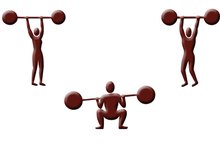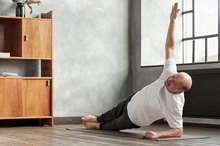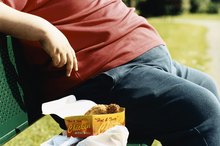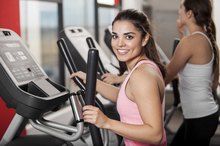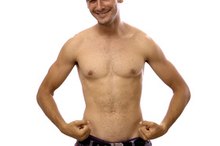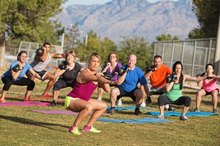What does fact checked mean?
At Healthfully, we strive to deliver objective content that is accurate and up-to-date. Our team periodically reviews articles in order to ensure content quality. The sources cited below consist of evidence from peer-reviewed journals, prominent medical organizations, academic associations, and government data.
The information contained on this site is for informational purposes only, and should not be used as a substitute for the advice of a professional health care provider. Please check with the appropriate physician regarding health questions and concerns. Although we strive to deliver accurate and up-to-date information, no guarantee to that effect is made.
The Best Diet Plan for Men Over 50
If you are a man over 50 who is overweight, you're risking high blood pressure, high cholesterol, heart disease and certain cancers--especially if you carry belly fat. You may require a different exercise and dietary plan than a younger man or a woman your age.
Calorie Consumption
Consume fewer than 2,000 calories if you are sedentary, more if you are active, to maintain your weight. "Sedentary" is defined as everyday light activities such as laundry or dishes or sitting for long periods. Increase activity levels or decrease calorie consumption--or, best, do both--to lose weight.
Healthy Diet
How to Increase Testosterone Levels in Men Over 60
Learn More
Eat a wide variety of vegetables, fruits, whole grains and nonfat dairy products. Consume 2 cups of fruit and 3 cups of vegetables daily to lose weight and maintain health. Thirty percent or fewer of your calories should come from fat, and only 5 percent to 10 percent of that should be saturated fat. Saturated fat is found in butter, processed foods, fatty meat and whole dairy foods. Give up those thick steaks and substitute healthy fats like fish, nuts, olive oil and sunflower oil. Choose lean cuts of meat and nonfat dairy.
- Eat a wide variety of vegetables, fruits, whole grains and nonfat dairy products.
- Choose lean cuts of meat and nonfat dairy.
Diet and Metabolism
Aging slows metabolism 1. Age-related muscle wasting, or sarcopenia, decreases the number of calories you burn because muscle burns fat. Men, on average, have a higher muscle-to-fat ratio than women, but you lose this edge as you age. To increase metabolism after 50 and lose weight, eat smaller meals more often during the day. This keeps your metabolism high throughout the day and helps burn fat.
- Age-related muscle wasting, or sarcopenia, decreases the number of calories you burn because muscle burns fat.
- Men, on average, have a higher muscle-to-fat ratio than women, but you lose this edge as you age.
Exercise
How to Get Your Small Waist Back After Menopause
Learn More
Increase weight-training exercises to increase musculature. Because muscle mass decreases over your lifetime, you must counteract it with exercise. Work out at least 30 to 60 minutes four or more times weekly. Perform upper- and lower-body strength-training exercises such as yoga, isometrics or weight training to increase muscle mass.
Include cardio/aerobic in your workout plan as well to burn fat. Aerobic exercise will help you to burn calories up to an hour after working out. Join a sports club or team to keep you active and healthy and get cardiovascular exercise that will lead to weight loss.
- Increase weight-training exercises to increase musculature.
- Perform upper- and lower-body strength-training exercises such as yoga, isometrics or weight training to increase muscle mass.
Related Articles
References
- Health.msn.com (Metabolism)
- Ahrq.gov
- Sharma HB, Kailashiya J. Gender difference in aerobic capacity and the contribution by body composition and haemoglobin concentration: a study in young indian national hockey players. J Clin Diagn Res. 2016;10(11):CC09–CC13. doi:10.7860/JCDR/2016/20873.8831
- Brightwell CR, Markofski MM, Moro T, et al. Moderate-intensity aerobic exercise improves skeletal muscle quality in older adults. Transl Sports Med. 2019;2(3):109–119. doi:10.1002/tsm2.70
- American College of Sports Medicine. Protein Intake for Optimal Muscle Maintenance.
- Bellemare F, Jeanneret A, Couture J. Sex differences in thoracic dimensions and configuration. American journal of respiratory and critical care medicine. 2003;168(3):305–12.
- Dilgate Muth, Nathalie, MD, MPH, RD. Do men and women have different nutritional needs? American Council on Exercise. March 21, 2012.
- Lewis D, Kamon E, Hodgson J. Physiological differences between genders. Implications for sports conditioning. Sports medicine (Auckland, N.Z.). 1986;3(5):357–69.
- Protein Intake for Optimal Muscle Maintenance, American College of Sports Medicine, (2015).
Writer Bio
Robin McDaniel is a writer, educator and musician. She holds a master's degree in higher educational leadership from Florida Atlantic University in Boca Raton as well as a bachelor's degree in elementary education. She is pursuing a Ph.D. in adult in community education. McDaniel enjoys writing, blogging, web design, singing and playing bass guitar.
